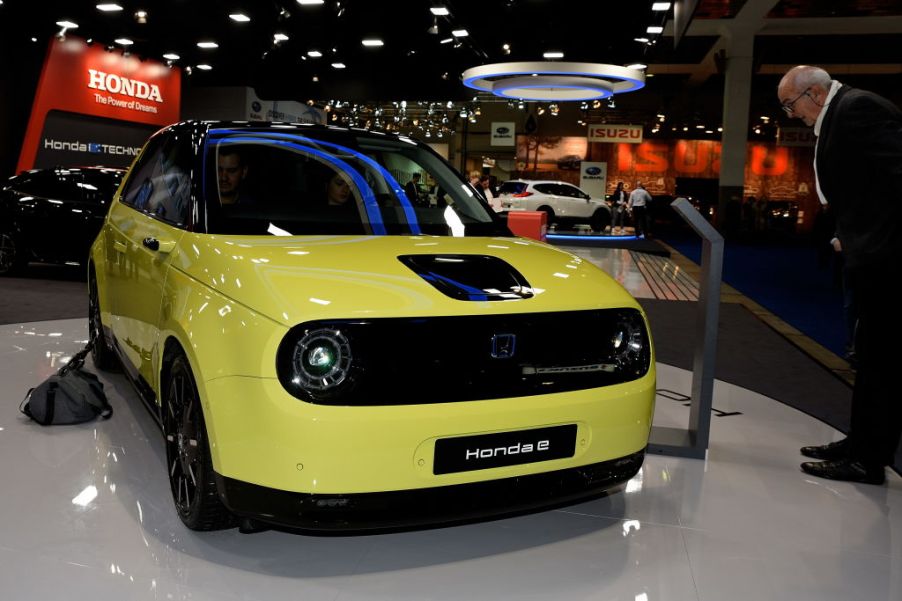
Will This Honda Model Ever Come to America?
The Honda e is the best little car you’ve never heard of, at least according to Car and Driver. This trendy compact hatchback was released to an enthusiastic market in Europe and Japan in January 2020. Honda’s recent partnership with GM for the development of electric vehicles bodes well for enhanced EV technology.
However, although Honda makes a strong showing in the U.S. auto market with its CR-V crossover and the midsized Accord, the automaker is reluctant to introduce the Honda e in the states.
What is the Honda e?
The Honda e is fondly described by Car and Driver as a “scrappy little city car.” With a fully electric motor, rear-wheel drive, and a 127-mile range, the e falls short of other electric compacts in range, but, according to Auto Express, it makes up its shortfalls with pure style. Myriad reviews praise the Honda e as charming, refreshing, and cute.
Even with the U.S. preoccupation with SUVs and crossovers, C&D speculates that Honda could find a market among the same people who love the unique charm of the Mini Cooper brand. With such high praise, you’d think Honda would want to try the Honda e in the U.S. market. Sadly, that does not seem to be the case.
Why can’t you get it in the U.S.?

Despite the Honda e’s undeniable appeal, Honda has a good reason for avoiding a U.S. release. The main concern is that the U.S. market leans heavily toward larger vehicles like trucks, SUVs, and crossovers. In fact, the top 5 best-selling vehicles of 2019, according to Business Insider were three pickups, an SUV, and a crossover, in that order. The good news for Honda is that the CR-V crossover was ranked as the fifth top-selling vehicle in the US.
Sales of compact cars and other sedans have steadily declined over the past decade in favor of trucks, SUVs, and then crossovers. SUVs and crossovers offer better visibility, more space, and a higher profile for enhanced offroad capabilities. Although gas mileage is noticeably worse in most SUVs, the combination of smaller crossovers and improved fuel technology has significantly reduced the difference. As Autotrader says, if a driver can buy a larger vehicle with only slightly higher fuel consumption, why wouldn’t they?
All told, Honda has made it abundantly clear that they have no interest in dropping the Honda e into the American market. The overall trend toward larger vehicles is not lost on them, and although there have been exceptions for particularly appealing vehicles, like the Mini Cooper, Honda is not willing to take that risk.
Challenges for electric vehicles in the U.S.
Honda doesn’t only face the challenge of larger vehicles in the U.S. Even if they were to consider a special release based on the popularity of niche vehicles, America offers numerous challenges for any automaker attempting to release a fully electric vehicle. While there are some urban areas with sufficient charging stations, they are few and far between.
According to the Bureau of Transportation Statistics, the average American driver puts 29 miles on their car daily. With a 127-mile range, the Honda e could certainly get the driver from point A to point B within the city, but extended travel becomes much more challenging.
In addition, environmentally-conscious buyers in urban areas might just as soon consider public transportation or biking. Investing $30,000 for an environmentally friendly ride to work rather than a couple hundred dollars for a bike or bus pass is a hard sell no matter how cute the car is.
The Honda e is just so appealing
Practicalities aside, the Honda e is unique and adorable, and it’s no surprise that it is wildly popular in urban and eco-friendly areas throughout Europe and Japan. With electric vehicles becoming more and more popular, perhaps Honda will reconsider their position in the future and give the U.S. a chance to appreciate all this tiny hatchback has to offer.


